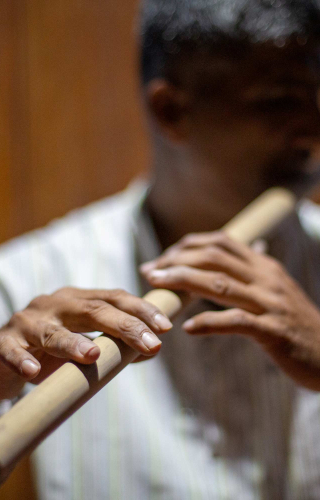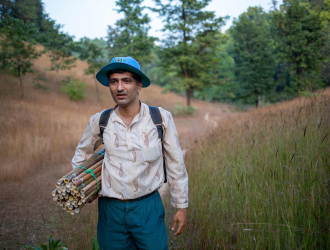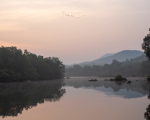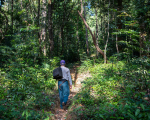Driving along the Kumta–Siddapur Road, it is easy to miss Valgalli, a village located 6 km from the coastal town of Kumta, in Karnataka’s Uttara Kannada district. The primary engagement in this 300-odd household hamlet is farming and horticulture. If you happen to be a flautist, this nondescript village is no less than a pilgrimage. Its reputation is linked to Satish Krishna Shanbag, who, over the years, has mastered the art of handcrafted bamboo flutes or bansuris. Musicians travel from far and wide to Valgalli to get their instruments improved, repaired, and custom-made by Satish.
Satish’s family has lived in Valagalli for generations, growing areca nut, paddy, and pepper. After finishing his ITI (Industrial Training Institute) training in Honnavar, Satish pursued a 2-year diploma in mechanical engineering from Hubli. While at Hubli, he shared a room with his classmate Viraj, who happened to be a flautist—this was his first exposure to the bamboo flute.
Satish’s uncle, VS Bhat, had a major influence on his musical inclinations. The first flute Satish received was a gift from him. VS Bhat played the harmonium and composed music for natakas (theatre). Satish was inspired by music rehearsals that happened at government schools, observing the instruments of the orchestra. Eventually, he decided to learn the harmonium and flute. Along the way, Satish picked up an old harmonium from his uncle, who was into repairing harmoniums.
In 1999, Satish formally started to learn music with MG Hedge, a multi-instrumentalist who was keen on promoting music among the youth of Kumta. It was with him that Satish chose to play the flute, and he continued training as a flautist for about 8 years. He also learned music from harmonium exponent Gowrish Yaji. He began attending local concerts, which usually happened from Dussehra till the end of May. In 2000, he tried his hand in making a bamboo flute. He received encouragement from Suresh Bhat, a flute maker who took flute classes in Kadatoka, a village about 15 km from Kumta.
After the untimely demise of his father in 2011, Satish had to shoulder agricultural responsibilities. His interest in music had already matured by then, but he had to figure out a way to strike a balance between running his household and his interest in flute making.
The bansuri is a combination of bans (bamboo) and sur (tone). For sourcing the bamboo, Satish started surveying forests of the Western Ghats that abound in bamboo groves. Bamboo growth is closely related to the nature of the soil, temperature, climate, and altitude. He looks for a particular variety of bamboo that grows along the Aghanashini River. Every year between February to May, when the water level is low, making the streams easy to cross, Satish goes trekking in the jungles of Doddamane, Badal, and Beeral Makki to scout for bamboo. Satish often takes a local guide with him, who has knowledge of the ecosystem of the forest and helps Satish in locating suitable bamboo clusters. Over the years, Satish has built a network of over a hundred such local sources who help him locate new clusters each year.
Satish collects only a few cut stems. He is conscious about not wasting young bamboo plants. ‘Elephants love this bamboo,’ he remarks, highlighting the role of bamboo in the Aghanashini River ecosystem. Satish says that the sound quality of a flute depends on the bamboo used. This bamboo, called vaate bidru in Kannada, has a thin form, with uniform wall thickness, and has enough length between two knots to fashion a long flute. The wall thickness of the bansuri determines the tone, range, and octave tuning. The diameter of the flute also varies based on the pitch. This kind of bamboo takes about 3–4 years to fully mature.
The flute is an important instrument in Indian Classical music, used both in Hindustani and Carnatic schools of music. In the Hindustani music of northern India, the flute is called bansuri. It has six finger holes and one embouchure hole. In Carnatic music of southern India, the flute used is called the venu. Regionally it is called pullankudal in Tamil Nadu, kurungu kuzhal in Kerala, veṇuvu in Andhra Pradesh, and koḷalu in Karnataka. It has eight finger holes and one embouchure hole. Bothbansuri and venu are transverse flutes, meaning they are blown from the side, in contrast to end-blown flutes which are more popular in folk music.
Back at his village, once farm duties are over, Satish settles to work on his flutes on the floor of his veranda, in natural sunlight. He lights up his custom-made stove over which he heats a set of steel rods of various thicknesses. He then picks out the bamboo that was kept to dry in the attic. Using a mathematical calculation, he roughly marks out the locations where the holes have to be made. Six holes are sufficient to produce the seven basic swara (musical notes: sa, re, ga, ma, pa, dha, ni). He then uses the heated steel rods to poke a couple of small holes, to begin with. After this step, Satish’s skill as a flautist comes into play—he repeatedly plays the notes to fine-tune the position of the holes, either by extending them proximally or distally or sometimes slightly up or down. The sound of a bansuri is generated from the resonance of the air column inside it. This calls for a very acute perception of the notes, and Satish has to be extremely attentive lest the holes are made any bigger than necessary.
A final detail is fitting the head cork to seal the blowing end of the flute. The degree of seal affects the pitch, response and tone. This is why proper placement of the head cork (optimal distance from the embouchure hole) is crucial. Any leak at the end of the flute affects every note. Placement of the head cork also affects intonation (distance between the notes). If it’s not in the right place, or if it’s too loose, the intonation and tone quality of the instrument will suffer. Satish has also figured out that the local fishermen’s floats make for a good head cork.
Flute making is a precise art, mastered through years of practice and training, which brings together knowledge of the natural world with knowledge of acoustics and music. Satish’s flutes are sought after by many upcoming flautists. Disciples of Pandit Hariprasad Chaurasia and Pandit Ronu Majumdar, and eminent flautists like Rajendra Prasanna, Rupak Kulkarni and Pravin Godkhindi have visited him, spending a day or two and get flutes made to their taste and preference. Test cricketer Shikar Dhawan, who has been learning the flute from Pandit Nityanand Haldipur, has also got one made by Satish.
However, growing fame has not fazed Satish. He is rooted in his humble surroundings in Valgalli. Farming is still Satish’s primary source of livelihood, and he prefers to keep it that way, ‘I want to make flutes out of passion and don’t want to be driven by money.’
This photo-essay has been created as part of the Sahapedia Frames Photography Grant, supported by CSR funding from IndusInd Bank.

















